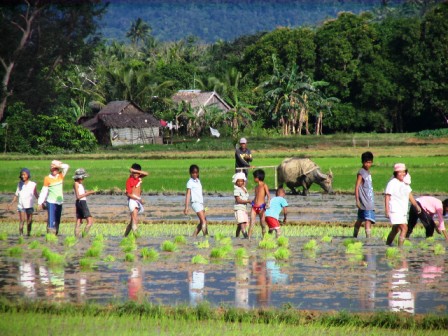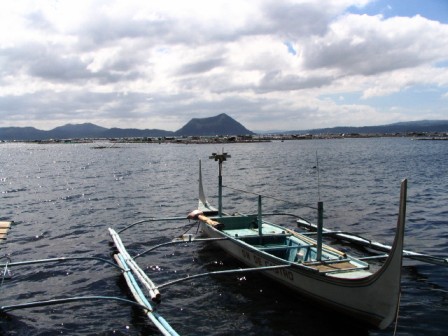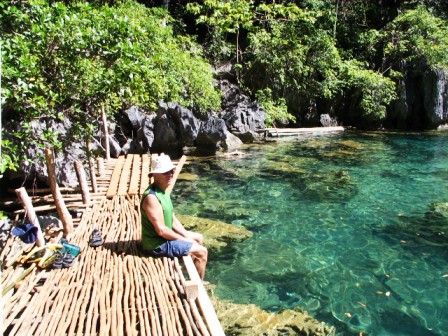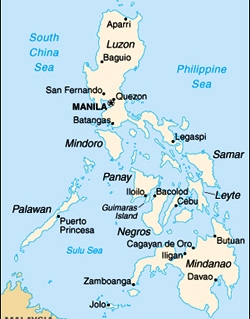|
29 December 2007 - 18 January 2008
 The day after the Long Beach
Festival we said goodbye to our host family and left to start our
independent travels in the
Philippines. Sibuyon is another island
in the Romblon group of islands. The island has a unique eco system with
many indigenous varieties of plants and animals not found anywhere else.
We planned to visit the huge Nature
Park,
go for a walk and experience the uniqueness of the island. This was not
to be. We arrived at the same time as a north-easterly weather system
that dumped rain on us every day, making the trails in the park
potentially muddy and dangerous. We contented ourselves with more
leisurely pursuits, swimming in the ocean and walking the roads around
the town of
Magdiwang. The day after the Long Beach
Festival we said goodbye to our host family and left to start our
independent travels in the
Philippines. Sibuyon is another island
in the Romblon group of islands. The island has a unique eco system with
many indigenous varieties of plants and animals not found anywhere else.
We planned to visit the huge Nature
Park,
go for a walk and experience the uniqueness of the island. This was not
to be. We arrived at the same time as a north-easterly weather system
that dumped rain on us every day, making the trails in the park
potentially muddy and dangerous. We contented ourselves with more
leisurely pursuits, swimming in the ocean and walking the roads around
the town of
Magdiwang.
We did have a very good place to
stay. The Beach Haus is on a nice sandy stretch of beach just outside
the town of Magdiwang. It is run by a
congenial pair of septogenarians who have built the establishment with
the help of their children as a retirement project. We think it is the
best place to stay on that part of the island.
The most common form of
transportation in the islands is on a tricycle, which is a motorcycle
with attached sidecar. The day before departing for Sibuyon we met
tourists complaining that they had trouble getting to the boat leaving
Sibuyon because there were no tricycles available. It turns out that was
the day the vehicle registration officials arrived from
Manila
to check that all local motorcycles and tricycles had been properly
registered. Of course only 5%, if that, of the owners have legally
registered their bikes. The inspectors move from island to island and
luckily the local grapevine works well. Somehow or other the day the
inspectors are in town there are no illegal vehicles on the road and the
inhabitants avoid nasty fines. The next day the inspectors left and all
the tricycles were back again looking for business.
The big issue in
Sibuyon these days is the threat of mining in
Sibuyon
Nature
Park.
An Australian company has requested nickle mining rights in the park.
They intend sending the raw ore to
Australia
and returning the tailings to Sibuyon to be used as landfill. The
Philippine Government is all for this project and have tried to persuade
the locals that this will be good for their economy. The locals are not
fooled. They fear an environmental disaster on their unique island.
Tempers were so high last October that a confrontation between a local
politician against the mining and a mining official that the local was
shot dead. This provided a martyr for the cause against mining. The
body, paraded from church to church all over the island, attracted large
crowds of supporters and new adherents of the anti-mining cause. The
issue is not yet resolved. We heard from several locals that they do not
trust the politicians and if called upon, they too would be willing
martyrs for the cause.
A visit to Tagaytay and
the famous Taal Volcano in
Lake Taal, had been on our itinerary since the
beginning of our trip. We had reserved a timeshare condo for a week in
Tagaytay and looked forward to exploring the area. A week is a bit too
long for Tagaytay but we did learn to relax.
 Tagaytay
is built along a 20 km ridge road overlooking
Lake Taal. The altitude is 640 M and the air
is cleaner and cooler than
Manila
and only 1 ½ hours from the city. This has resulted in an overabundance
of housing developments, some around golf courses, hoping to entice
wealthy Manila residents to buy a vacation home. Development roads
sprawl over the lake side of the ridge and over the opposite valley side
of the ridge, but the number of homes currently built remains small. Our
condo in
Sunset Holiday
Mansion
was part of the huge Royale Tagaytay Estate about 13 km west of Tagaytay
town center. We had a nice hotel style unit overlooking the pool with a
microwave and fridge. Tagaytay
is built along a 20 km ridge road overlooking
Lake Taal. The altitude is 640 M and the air
is cleaner and cooler than
Manila
and only 1 ½ hours from the city. This has resulted in an overabundance
of housing developments, some around golf courses, hoping to entice
wealthy Manila residents to buy a vacation home. Development roads
sprawl over the lake side of the ridge and over the opposite valley side
of the ridge, but the number of homes currently built remains small. Our
condo in
Sunset Holiday
Mansion
was part of the huge Royale Tagaytay Estate about 13 km west of Tagaytay
town center. We had a nice hotel style unit overlooking the pool with a
microwave and fridge.
Besides instant noodles
in the microwave, we did have a few good meals.
A highlight was our
lunch at Sonja’s Garden Restaurant and B&B. Lonely Planet raved about
this place and we discovered on one of our walks that it was not far
from our condo. It was a truly fabulous place with buildings hidden
amongst a gorgeous botanical garden. Lunch was a splurge for us but well
worth it. Tables with embroidered clothes in a greenhouse building, lit
by unique Venetian glass chandeliers waited for luncheon guests who soon
arrived to fill the room. Lunch was an all-you-can-eat set menu of
tossed salad, homemade bread, pasta and desert. Drinks were fresh orange
drink and tarragon tea. Each course came with small bowls of condiments
and sauces to add to the selection. We haven’t eaten so much or so well
since we arrived in the
Philippines, all for a total of $30
CDN. If you are ever in Tagaytay, make a visit to Sonja’s a priority.
Taal Volcano was
recently listed as one of the world’s top ten difficult to get to places
to see. We agreed that it was not an easy access and was interesting,
but it might not make our top ten list. Taal Volcano is in the
middle of Lake
Taal. We took two jeepney rides and two
tricycles to reach Talisay, the village on the edge of the lake, where
we bargained for a bangka boat and driver to take us across the lake.
After passing hundreds of tilapia fish farms clustered near the Talisay
shoreline, we started to get hit by waves breaking over the bow of our
small wooden boat. We hadn’t realized the wind would affect our ride
across the lake as much as it did. The boat driver suggested we use
tarpaulins kept in the bottom of the boat as protection against the
waves. Even holding the tarp up to our chins we still got soaked when
the waves hit us on the head and splashed down our fronts. Thank
goodness it was a warm day.
Despite our fears we
arrived safe but wet half hour later on the island. Several larger
boatloads of Korean tourists arriving at the same time, rushed to mount
small horses for the trip up the hill to the rim of the volcano. It
reminded us of the donkeys ferrying tourist us the cliffs to Fira on
Santorini. It was a hot and dusty 45 minute hike straight up to the rim
for us, stopping along the way to get out of the way of the horses and
gulp lots of water. The volcano was most unusual. A big eruption of the
volcano in 1911 left a huge crater that has since filled up with
sulfurous smelling water. The volcano is dormant but still active, as
evidenced by small plumes of smoke around the rim. Seismic readings are
monitored from Talisay but no major activity is expected soon.
We stayed looking at
this lake-within-a-volcano-within-a-lake from several different vantage
points before descending again and braving another wet trip back across
the lake. We celebrated our return with a beer and a grilled tilapia
dinner prepared by the manager of the bangka.
Tourist visas for the
Philippines are
granted for a maximum of 59 days. That meant we had to return to Manila to extend our visas
to last until our departure March 3. That was a relatively easy but
expensive undertaking. We presented ourselves soon after the Visa office
opened at 8 AM, filled out forms, included all necessary photocopies of
our passport and proof of entry stamps and handed in our passports after
paying the exorbitant sum of P3790, about $95 each. We paid P500 for
each of two additional months and another P500 for processing of the
visa within 24 hours. The rest of the charges were various taxes and
fees. Considering we paid $34 in
Ottawa for the
first 59 days, this was expensive, but that is how it is. We considered
ourselves lucky to return at 2 PM that same day and find our visas ready
for us.
Visas in hand, we flew
out of Manila the next day to
Busuanga
Island, in the northern part of
Palawan. This is a divers spot, especially to see sunken
Japanese ships from WWII. It was fun looking down on small tropical
islands from our 19 passenger plane and anticipating some good
snorkeling opportunities amongst the islands surrounding Busuanga. It
was a 45 minute rough jeepney ride to
Coron Town, the largest town on Busuanga but
really a small fishing village on the cusp of tourism. Most of the
houses are built on stilts over the water, as is our hotel, Sea Dive. We
are pleased with our accommodation. Nothing luxurious but we have a good
sized room with shower, the restaurant is good and their dive facilities
are first class.
 We found another couple
to share an Island Hopping and snorkeling boat trip. We had great
snorkeling at a group of rocks called Siete Pecados (Seven Sisters),
motored past green covered karst peaks,
swam in a lake that boasts both
fresh and salt water, swam under a rocky bridge to access an inner
lagoon lined with brilliant coloured corals and basked on a white sand
beach. We were almost the only visitors in each of these places. Ray
remarked that people search all over the world to find such beautiful,
peaceful and uncrowded places as these. We found another couple
to share an Island Hopping and snorkeling boat trip. We had great
snorkeling at a group of rocks called Siete Pecados (Seven Sisters),
motored past green covered karst peaks,
swam in a lake that boasts both
fresh and salt water, swam under a rocky bridge to access an inner
lagoon lined with brilliant coloured corals and basked on a white sand
beach. We were almost the only visitors in each of these places. Ray
remarked that people search all over the world to find such beautiful,
peaceful and uncrowded places as these.
Another day Ray and I
rented a two person wooden bangka, similar to a kayak with bamboo
outriggers, and paddled our way around the coast and across the bay. We
couldn’t go as fast as a kayak, but the bangka was amazingly stable. We
found a small pebbly beach to land on and have a swim and we paddled
past a few of the more expensive resorts on neighbouring islands.
| 